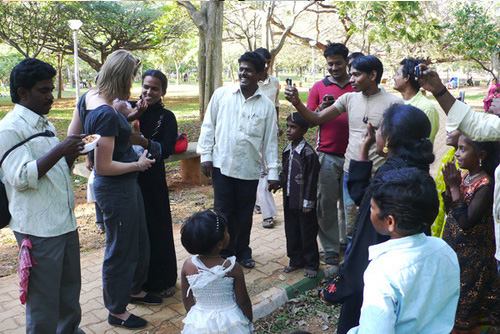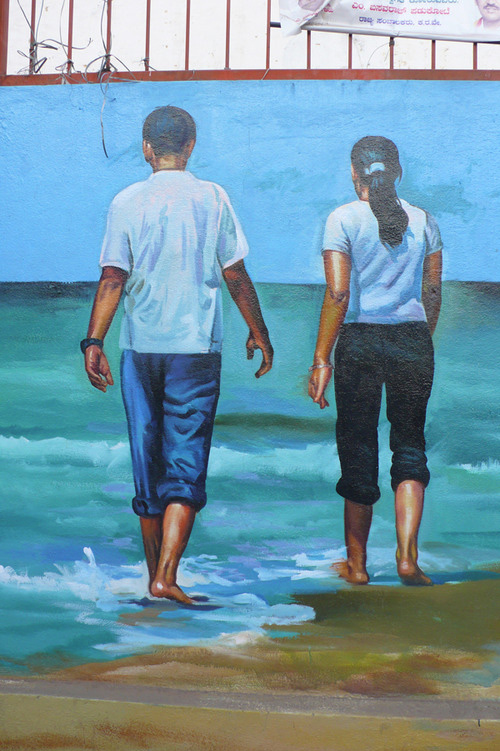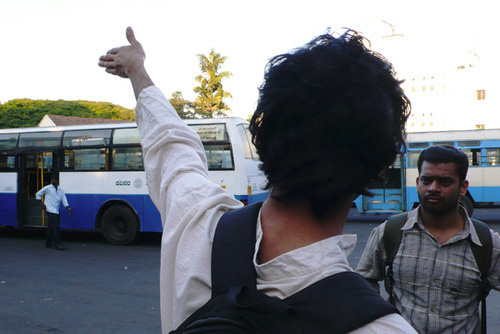Sunday, March 14, 2011
Sunday.
Sweet Sunday.
Sunday sounds like shopping.
Sounds like shopping and sun.
Open the brackets : A bunch of students gather at Cubbon Park at 15.45 – or even a bit later – and join Srishti faculty Deepak Srinivasan – artist, media practitioner, researcher and pedagogue. The group sits on a stone, as Deepak introduces the main topic of this Sunday afternoon walk – thoughts about public space – and asks the students how they relate to the particular context of Bangalore. The students of the DAI, the “white foreigners”, evoke the particular rhythm of this city : time seems expanded while travelling by rickshaw or by bus, given the size of the city and the traffic jams. When walking down the busy streets of Commercial Street, or by crossing a busy road, some feel like blending in a flow, an organic movement that materialises in making three steps to pass a rickshaw, wait for the bus to go and finally run to the other side in diagonal. Some of us have also witnessed people brushing their teeth in the streets, as if the private sphere had merged with the public space. Like in Cubbon Park, where families sit on the grass despite the do no sit on the lawn signs, Bangaloreans seem to take over the public space, to appropriate it.
Deepak then proposed a reflection on the way gender is performed in public, through an half an-hour exercise : students were asked to form pairs of men and women, walk in the park, observe the opposite gender, incorporate the gestures that characterise a man or a woman, and come back acting likewise. Thirty minutes later, the whole group hadn’t been very assiduous, but those who had, came up either with playful observations, or with a feeling of vulnerability, especially for women. Generally speaking, the very fact to be a white women in Bangalore involves a lot of emphatic looks from men; trying to walk like a man for the exercise made some women feel even more observed, and therefore uncomfortable. The mimics sounded like pure spectacle. The group seems to agree that it is easier to stand as an observer, which allowed Deepak to underline the notions of visibility and invisibility in public space. About the social and political context of Cubbon Park, Deepak mentioned that it was mainly used by lower middle class people, mainly Muslim families from Shivajinagar, the neighbouring commercial area. Throughout history, the park has been the main component of a subtle but menacing composition of city planning speculation (parking lots, government buildings, metro station), security policy and protests.
The walk headed then to Shivajinagar and its colourful, odour full and plastic-goods-full commercial streets. We passed a lot of wall paintings on our way, that I personally found beautiful. Deepak couldn’t agree, and mentioned the polemic in which these paintings have been involved, in terms of the nationalistic images of India that they present, but also because of a “Singapore syndrome” – understand the recent government’s quirk for clean streets. By replacing the Bollywood posters that used to cover these walls, this policy has also deprived income for the people who were living from the poster industry.
Further on, Deepak briefly explained the project that his collective, Maraa set up in Virapillai Street, where they displayed images that had been taken there, which depicted the area’s everyday life. This self-reflective work raised questions from the locals about the issue of the set-up : why does one show images of old buildings when the city is developing and growing so fast? Could they not better exhibit images from the new malls?
On the way back to Commercial Street Deepak also mentioned a project he set up last year with a group of Srishti students : in the flower market the undergraduates had to observe the traders and their gestures. After this ethnological survey, they spent a day working with the flower traders, dressing like them, according to their previous research.
An inscription in Tamil on a very colourful Hindu temple led Deepak to briefly introduce us to the tensions that divide the Tamil and Kannada groups in Bangalore. But that’s when the owner of the shop in front of where we were standing asked us to leave, because potential customers weren’t able to see his storefront. Negociating the public space…
Deepak left us in Commercial street, with its Western-style shops and its police station, which occasionally gathers street vendors demonstrations – another side-effect of the ‘Singapore syndrome’. Close the brackets.
The sun has gone.
But the shopping still goes on.




March 22nd, 2011 at 8:18 pm
“The students of the DAI, the “white foreigners” “……I feel a little bit in-betweeness here……considering the fact I’m not a “white foreigner”……